
Beach nourishment describes a process by which sediment, usually sand, lost through longshore drift or erosion is replaced from other sources. A wider beach can reduce storm damage to coastal structures by dissipating energy across the surf zone, protecting upland structures and infrastructure from storm surges, tsunamis and unusually high tides. Beach nourishment is typically part of a larger integrated coastal zone management aimed at coastal defense. Nourishment is typically a repetitive process since it does not remove the physical forces that cause erosion but simply mitigates their effects.
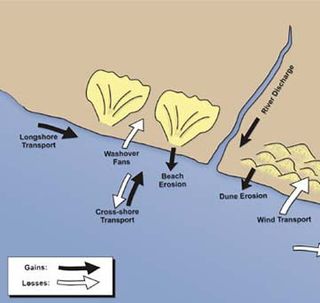
Sedimentary budgets are a coastal management tool used to analyze and describe the different sediment inputs (sources) and outputs (sinks) on the coasts, which is used to predict morphological change in any particular coastline over time. Within a coastal environment the rate of change of sediment is dependent on the amount of sediment brought into the system versus the amount of sediment that leaves the system. These inputs and outputs of sediment then equate to the total balance of the system and more than often reflect the amounts of erosion or accretion affecting the morphology of the coast.
Pier Vellinga is an environmental scientist and one of the Netherlands' experts on the impacts of climate change.
Large-scale coastal behaviour is an attempt to model the morphodynamics of coastal change at time and space scales appropriate to management and prediction. Temporally this is at the decade to century scale, spatially at the scale of tens of kilometers. It was developed by de Vriend.
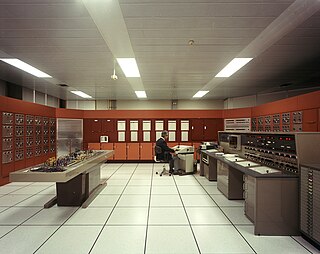
The Deltar was an analogue computer used in the design and execution of the Delta Works from 1960 to 1984. Originated by Johan van Veen, who also built the initial prototypes between 1944 and 1946, its development was continued by J.C. Schönfeld and C.M. Verhagen after van Veen's death in 1959.
A mouth bar is an element of a deltaic system, which refers to the typically mid-channel deposition of the sediment transported by the river channel at the river mouth.

The sand engine or sand motor is a type of beach nourishment where a large volume of sediment is added to a coast. The natural forces of wind, waves and tides then distribute the sand along the coast over many years, preventing the need for repetitive beach nourishment. The method is expected to be more cost effective and also reduces the repeated ecological disturbances caused by replenishment.

Jurjen Anno Battjes is a Dutch civil engineer. He was a professor of fluid dynamics at Delft University of Technology until his retirement in 2004.
Estuaries of Australia are features of the Australian coastline. They are linked to tides, river mouths and coastal features and conditions. In many cases the features of estuaries are also named inlets.
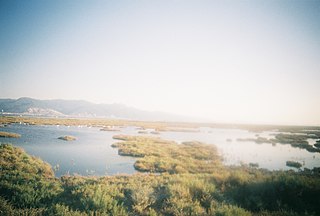
Sedimentation enhancing strategies are environmental management projects aiming to restore and facilitate land-building processes in deltas. Sediment availability and deposition are important because deltas naturally subside and therefore need sediment accumulation to maintain their elevation, particularly considering increasing rates of sea-level rise. Sedimentation enhancing strategies aim to increase sedimentation on the delta plain primarily by restoring the exchange of water and sediments between rivers and low-lying delta plains. Sedimentation enhancing strategies can be applied to encourage land elevation gain to offset sea-level rise. Interest in sedimentation enhancing strategies has recently increased due to their ability to raise land elevation, which is important for the long-term sustainability of deltas.

The Grevelingendam is a dam located in the Grevelingen sea inlet between Schouwen-Duiveland and Goeree-Overflakkee in The Netherlands. The Grevelingendam was the fourth structure constructed as part of the Delta Works.

Pieter Jacobus (P.J.) Wemelsfelder was a Dutch hydraulic engineer who made significant contributions to the field of hydrometry in the Netherlands, and in hydraulic engineering internationally. In addition to his involvement in the design and planning of the Delta Works, he published widely and is notable for the first use of probability theory in the design of flood levels.

Wind setup, also known as wind effect or storm effect, refers to the rise in water level in seas, lakes, or other large bodies of water caused by winds pushing the water in a specific direction. As the wind moves across the water’s surface, it applies shear stress to the water, generating a wind-driven current. When this current encounters a shoreline, the water level increases due to the accumulation of water, which creates a hydrostatic counterforce that balances the shear force applied by the wind.

Robert Nicholls is currently the Director of the Tyndall Centre for Climate Change Research and a professor of climate adaptation at the University of East Anglia in Norwich, United Kingdom.
Jo Johannis Dronkers was a Dutch mathematician who is notable for the development of mathematical methods for the calculation of tides and tidal currents in estuaries. His work formed much of the mathematical basis for the design of the Delta Works. He attended the 1954 International Congress of Mathematicians in Amsterdam, where his work was discussed by David van Dantzig.

Johannes Theodoor Thijsse was a Dutch hydraulic engineer who made significant contributions to hydraulic engineering both in The Netherlands and internationally. In addition to having a major involvement in the design and planning of both the Zuiderzee Works and the Delta Works, he published widely and played a key role in the establishment of the IHE Delft Institute for Water Education.
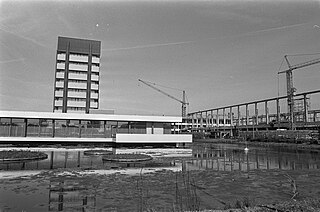
The Waterloopkundig Laboratorium was an independent Dutch scientific institute specialising in hydraulics and hydraulic engineering. The laboratory was established in Delft from 1927, moving to a new location in the city in 1973. The institute later became known as WL | Delft Hydraulics. In 2008, the laboratory was incorporated into the international nonprofit Deltares institute.

Pieter Philippus Jansen was a Dutch civil engineer and hydraulic engineer who made significant contributions to hydraulic engineering in The Netherlands. He spent the majority of his career with Rijkswaterstaat, working on several major projects including the first phase of the Delta Works and leading the reclamation and repair efforts following the inundation of Walcheren.
A compartmentalisation dam is a dam that divides a body of water into two parts. A typical use of such a dam is the regulation of water levels separately in different sections of a basin. One application of a compartmentalisation dam is to facilitate closures of areas with multiple tidal inlets, such as in the case of the Delta Works.
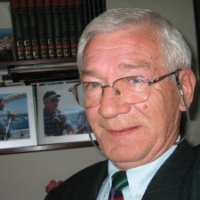
Krystian Walenty Pilarczyk is a hydraulic engineer whose contributions to civil and hydraulic engineering include the development and improvement of the Izbash formula, along with the Pilarczyk formula for the stability of block revetments. He is the author and editor of a number of academic papers and textbooks on coastal, river, and hydraulic engineering subjects.














